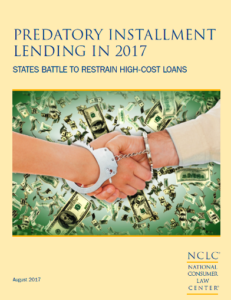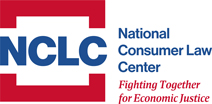This National Consumer Law Center survey updates our 2015 report that analyzed the strengths and gaps of the statutes in the 50 states and the District of Columbia that regulate installment loans. Our new analysis finds both gains and losses, and increasing pressure on states to weaken rules as restrictions on payday loans increase.
 Published: August 2017 Published: August 2017 |
|
Additional Resources
- 2020 report (updated APRs for sample $500 and $2,000 closed-end loans with new maps and charts): Predatory Installment Lending in the States: 2020 , February 2020
- 2018 report: A Larger and Longer Debt Trap?: Analysis of States’ APR Caps for a $10,000 Five-Year Installment Loan, October 2018
- 2015 report (includes comprehensive information on state statutes): Installment Loans: Will States Protect Borrowers from a New Wave of Predatory Lending?, July 2015
- Misaligned Incentives: Why High-Rate Installment Lenders Want Borrowers Who Will Default, July 2016
- Why Cap Small Loans at 36%?
- More Usury resources prohibiting lenders from charging borrowers excessively high rates of interest on loans
Executive Summary
When the National Consumer Law Center published the report Installment Loans: Will States Protect Borrowers From a New Wave of Predatory Lending? in July 2015, predatory installment lenders were moving into the states, seeking statutory authority to make consumer installment loans at sky-high interest rates. The report analyzed which states allowed high-cost installment lending and which did not, but warned that state laws that protect citizens from predatory high-cost lending were under attack.
Since then, battles have raged around the country. In state after state, high-cost lenders sought to weaken state laws that protect consumers from predatory installment loans by non-banks. Typically the lenders pushing these proposals have been payday lenders, seeking to double down on the types of predatory loans offered in the states. Consumers and their advocates fought back, trying not only to defeat bills that would open the floodgates to predatory loans but also to tighten up existing state laws, which our 2015 report showed were often full of loopholes.
These battles have resulted in both gains and losses for consumers. The most striking gain is in South Dakota, which formerly placed no caps on interest rates or fees. Voters there passed a ballot initiative by a landslide that caps interest and fees for all loans made in the state at 36%—thereby throwing both payday lenders and high-cost installment lenders out of the state and saving South Dakotans $84 million a year. Maryland placed a firm 33% cap on credit card and other open-end lending by non-banks, so there is no longer a danger that lenders can charge a reasonable-sounding interest rate but then add on sky-high fees.
On the other hand, Mississippi legislators enacted the misleadingly named “Mississippi Credit Availability Act” that allows an APR of 305% for a $500 loan repayable over six months. The state joins Tennessee, which amended its lending laws in 2014 to allow non-bank lenders to make cash advances at 279%, to make up the “Terrible Two”—the two states that have done the most to open their doors even wider for predatory lending practices in recent years.
As in our 2015 report, we have calculated the full annual percentage rate (APR) that each state allows for four sample loans. These “full APRs” include all fees that the consumer is bound to pay in order to obtain and use the extension of credit, even those that are not included in the Truth in Lending Act (TILA) APR.
For a $500 six-month loan with all fees included:
- 21 states (up one from 2015) now cap the full APR at 36% or less,
- 12 states (down one from 2015) cap it at 36% to 60%,
- 11 states (up one from 2015) cap it at over 60%,
- 4 states have no cap other than unconscionability, and
- 3 states (down one from 2015) have no cap.
For a $2000 two-year loan:
- 33 states and the District of Columbia (up one from 2015) now cap the APR at 36% or less,
- 6 states cap it at 36% to 60%,
- One state caps it at over 60%,
- 6 states have no cap other than unconscionability, and
- 4 states (down one from 2015) have no cap at all.
The report includes charts, tables, and maps showing these changes, and provides a similar analysis of the changes affecting cash advances on credit cards or other open-end lines of credit, which are often governed by different state laws. These and other developments since 2015 are detailed in the report. The report concludes with tips for consumers and recommendations for the states.
Recommendations for States
With respect to state laws that affect the interest rates for fees that can be charged for consumer loans, states should:
- Examine consumer lending bills carefully. Predatory lenders often propose bills that obscure the high cost of the loans the bill would authorize. For example, the flex loan bill that Tennessee passed in 2014 facially allows just a 24% interest rate but, in fact, the APR is 279%. Get a calculation of the full APR, including all interest, all fees, and all other charges, and reject the bill if it is over 36%.
- Place clear, loophole-free caps on interest rates for both installment loans and open-end credit, in addition to closed-end, short-term payday and car title loans. A maximum APR of 36% is appropriate for smaller loans, such as those of $1000 or less, with a lower rate for larger loans.
- Prohibit or strictly limit loan fees in order to prevent fees from being used to undermine the interest rate cap and acting as an incentive for loan flipping.
- Ban the sale of credit insurance and other add-on products, which primarily benefit the lender and increase the cost of credit.
In addition, states should make sure that their installment loan laws address other potential abuses, including:
- Require lenders to evaluate the borrower’s ability to repay any credit that is extended—including an analysis of the borrower’s income and expenses. States should, however, be wary of proposals to enact weak ability-to-repay requirements that merely act as window dressing for high-cost loans.
- Prohibit devices, such as security interests in household goods and post-dated checks, that coerce repayment of unaffordable loans.
- Require full and fair proportionate rebates of all up-front loan charges when loans are refinanced or paid off early.
- Limit balloon payments, interest-only payments, and excessively long loan terms.
- Employ robust licensing and reporting requirements for lenders and make unlicensed or unlawful loans void and uncollectible. However, states should be wary of efforts to open up licensing regimes so that high-cost lenders can enter the market in the state.
- Minimize differences between state installment loan laws and state open-end credit laws so that high-cost lenders do not simply transform their products into open-end credit.
- Tighten up other lending laws, including credit services organization laws, so that they do not serve as a means of evasion.
A thorough discussion of all the issues addressed in this report, along with detailed updated summaries of the laws it discusses, may be found in the 2017 online update to the National Consumer Law Center’s publication Consumer Credit Regulation.
